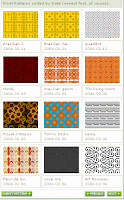
I can't stop with the pixel patterns. This gallery of gifs is pure pleasure. Tile them on your desktop, protopage background, everywhere! Now to try making some--that's when you realize how artful these are. Actually, when you think of it, there must be some techniques to making them tile properly.
Link








